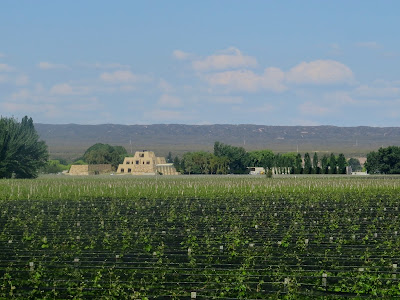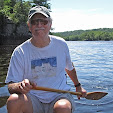From Salta, Dan and I flew south to Córdoba and then west to the next stop on our excursion, the west-central city of Mendoza. The provincial capital and its metropolitan area comprise a population of a bit over a million.
Like Salta, this part of Argentina rubs shoulders with the Andes, but here the proximity seems more immediate, with the snow-capped peaks of some of the highest mountains in the Americas serrating the western horizon. At their feet, the broad sweep of the Monte Desert, rendered arable here by constant runoff from the glaciers of the Cordillera.
 |
| IMAGE: WinePedia.info |
Another of Mendoza’s draws is as a tourist destination. For the wine, yes, but also for a broader, bourgeoning ecotourism industry. The capital city also serves as a jump-off point for climbing expeditions to some of the Andes’s most spectacular peaks, just over 100 kilometers to the west.
(As we cabbed from the airport to our lodging, we spotted one especially stunning snow-capped peak. We assumed it must be Aconcagua, at 22,841 the world’s highest peak outside of Asia. Later we learned that what we’d seen was actually Cerro El Plomo, a mere pipsqueak at just 18,000 feet.)
 |
| Aconcagua – IMAGE: WikiPedia |
I discovered that—God strike me dead—
I don’t really like malbec.
MORE MEAT
We stayed at Lares de Chacras, an elegant-but-unpretentious boutique hotel in the upscale south-metro neighborhood of Chacras de Coria. This part of town is considered the gateway to the Ruta del Vino, or wine route, with stops at a select 15 of the Mendoza area’s 1,500-and-then-some wineries.
(As if we hadn’t known we were in serious wine country, our hotel’s entrance foyer has a glass floor, showing off its own modest wine cellars below.)
Once we’d settled into our room, we headed to Lares’s very inviting patio, where we met two of our fellow guests, women friends from New Zealand, both wine enthusiasts. And here’s where Dan was perhaps most in his element, discussing the merits of various wines, including those of their country and of Australia.
After a nice glass of wine, we were summoned to the outdoor terrace dining area, now joined by a pleasant couple from England, for our asado Argentino, or Argentine barbecue. It appeared that, for most of this group, the wines were the stars of the show. I, with my less sophisticated palette, appreciated the wine, but found that the several-course presentation of various grilled meats gave the vino a run for its money.
(Ironically, it is here, in the malbec capital of the world, I discovered that—God strike me dead—I don’t really like malbec. Maybe it’s the dryness; maybe the ample tannins. But I prefer the somewhat lighter and sweeter Cabernets. In fact, truth be told, I enjoy a good strong mixed drink more than most any wine—though in this wine-centric country cocktails proved hard to come by.)
 |
| Five-liter jugs of malbec line the aisles of a small market. |
A word about Chacras de Coria: Situated as it is on this broad sweep of flat, open desert, the town surprised us with its lush, oasis-like feel. The streets and roads, well-shaded by phalanxes of gigantic sycamores, pass a range of structures, ranging from modest homes and workaday shops to showy estancias, upscale restaurants, exclusive gift boutiques and of course wine shops.
 |
| IMAGE: Trip Advisor |
UNDER THE TABLE
Next morning we headed out on our own little wine tour, to two wineries Dan had researched. First on foot to the small La Bodega Canepa, where the current co-owner’s girlfriend, Betiana, gave us a low-key, yet informative, tour of the facility, which has been owned by members of the Canepa family since the 19th century.
Betiana also provided us with a tasting, comparing of some of their styles and vintages, with the obligatory crackers to cleanse the palate between samples. Dan asked if they provided spittoons, one would assume to avoid having his taste buds dulled by inebriation. I and the two twenty-something Argentine men who’d joined us had no such concern.
 |
| IMAGE: Dan Willius |
 The tasting room itself was memorable. We sat around a glass-top table whose large barrel base is full of corks. One wall is a work of art, a weave of curved barrel staves. Even some of the furniture is crafted of wine-stained staves.
The tasting room itself was memorable. We sat around a glass-top table whose large barrel base is full of corks. One wall is a work of art, a weave of curved barrel staves. Even some of the furniture is crafted of wine-stained staves.The wines were wonderful, but were
all but upstaged by the spectacular
“tomahawk steak.”
THE HUE OF A VINTNER’S SMILE
After a nice picnic lunch, we called a taxi for the jaunt to our second winery, Piattelli Vineyards, located in Luján de Cuyo, a distinct wine region some 25 miles south of Lares de Chacras. (Lucky we’d opted against our original plan to rent bicycles for our wineries tour!)
Piattelli had caught Dan’s attention for a couple of reasons. First, he’d found and enjoyed some of their wine back home in Minneapolis. Second, it turned out the owners are actually from Minneapolis. Alas, they were not at the winery the day we visited. Nonetheless, we were treated to a private, two-and-a-half-hour tour and tasting experience.
Just outside the spacious, warmly decorated reception hall is a lovely patio which overlooks a holding pond—used to collect and distribute, as needed, the precious run-off from the adjacent mountains. And just beyond the pond—and all around—the vineyards. Somehow the lovely setting seemed even more idyllic when we noticed the pond is full of trout—good-size trout!
Our three-course tasting menu included salad, main course and dessert, each accompanied by either one or two Piattelli wines, most from this vineyard, but one from the company’s other vineyard back in Cafayate.
The wines were wonderful, but were all but upstaged by the spectacular “tomahawk steak” a bone-in rib eye that not only filled our good-sized plates, but whose bone extended six inches beyond.
As unexpected as this unhurried, personal conversation with the vintners seemed to me, Dan had come prepared, with pages of questions for them. They appeared quite impressed with the sophistication of his questions, and I felt happy and proud to see him so engaged and energized in this, one of his chief passions.
BLUE FOUNTAINS
Our last day in Mendoza we headed into the city center to explore and take pictures.
La Plaza de Independencia, along with a quadriplex of other, smaller parks surrounding it a few blocks away, was created following the earthquake that destroyed the city in 1861 as an open-air refuge for Mendocinos in the event of other such disasters.
There are several fountains, a couple of them spouting blue-dyed water—I think I like water’s natural “color” just the way it is, thank you. The largest fountain is the ambitious Friso de la Independencia, a sweep of squirting sculpture representing everything from indigenous peoples, to the Spanish conquest, to liberation, to more recent political and social strife.
One side of the park opens onto lovely Avenida Sarmiento, a cobbled, shaded pedestrian street lined with cafes and animated with street performers.
Next, we rode out to the western fringes of the city to the Cerro de la Gloria, a hill overlooking Mendoza, and home of the Monumento al Ejército de Los Andes, the Monument to the Army of the Andes. This colossal memorial stands over seven stories tall and embodies some 14 tons of bronze. It is the work of Uruguayan sculptor Juan Manuel Ferrari, who, along with several Argentine sculptors, created it from 1911 to 1914 in observance of the centennial of the country’s independence from Spain.
Among the dramatic allegorical depictions, dominant are figures of the soaring, winged Lady Liberty, the heroic General San Martin, leader of the victorious rebellion, and a huge condor that somehow manages to emerge, soaring, from under the pounding hooves of the horses.
(A word of advice: If you ever visit the Cerro de la Gloria by taxi, be sure to have the driver wait for you. Finding a cab back down to the city proved to be quite a challenge. We ended up having to share the one that had waited for an hilarious couple from Curaçao, who playfully demanded all but our first borne great-grandchild for the privilege.)
That evening, back in Chacras de Coria, we walked from our hotel to a restaurant with a lovely, tree-canopied deck. Over a beer and a light meal we culled some of the day’s worst photos from our cameras and recapped our brief time in this memorable place.
Tomorrow, poignantly, we’re off on the final leg of this incredible two-and-a-half-week swing through Argentina—to Bariloche, San Martin de los Andes, and some amazing—we hope—trout fishing.






































































